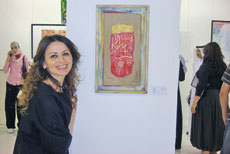IN a world sated with greed, dishonesty and deception, art can bring us the serenity, peace and harmony we lack in our everyday lives. Ola Hejazi, a Saudi artist living in Jeddah attempts to recreate through her paintings an atmosphere of tranquility and beauty. Her art provides a haven from the instability of our modern world. In her quest for an original and refreshing pictorial expression along with her innovative use of materials, she has unleashed a stream of new and exciting images.
Hejazi is particularly aware of the role of the plastic arts and the importance of revivifying the concept of beauty which is intrinsically linked to truth. She is known, in particular, for her unique way of using printing ink on her canvas. She is also inspired by the Arabic alphabet: “The letters look like drawings” she says.
The traditional art of Arabic calligraphy has been described by Abu Hayyan Al-Tawhidi as “Jewelry fashioned by the hand from the pure gold of the intellect” and Ali ibn Abi Talib said: “The beauty of writing is the tongue of the hand and the elegance of thought.” Ola uses Arabic calligraphy in a modern way. She draws the letters the way she feels, according to her mood and emotion and does not follow any specific style.
She also enjoys mixing colors with poetry, especially poems composed by Mahmud Darwish which she considers the greatest Arab poet. “I enjoy reading Arabic literature, and sometimes, I like to express in written words, on the canvas, the emotions I feel from reading poetry. The fusion, so to speak of words and colors seems to me an ideal form of art,” Hejazi explains.
Her use of bold colors, particularly red and blue, her favorites, produces a stunning effect so that the light falling across the surface of the canvas creates a remarkable sparkle and contrast. All her paintings are characteristically untitled. She fears that a title would restrict the scope of our imagination. She wants us to be totally free and uninhibited while searching for the meaning of her paintings. When I asked her what one should look for in a painting, she immediately answered: “Past experiences.” Her definition of a good painting is based on how well one can relate to it through our emotions and thoughts.
Besides her own painting, Hejazi trains teachers to develop their teaching experience into an artistic pursuit whereby they can work in a more creative way. She also teaches art to children and is overwhelmed by “the children’s wonderful spirit, their simplicity, honesty, and their quick ability and eagerness to learn.”
Despite her busy schedule, Hejazi finds time to paint for at least two to three hours. She does not consider painting as a job: “Art is part of my personality and my being,” she explains. She is planning to have her 4th solo exhibition in Jeddah after the summer holidays.
She is a visionary artist and her art is imbued with a rejuvenating harmony which triggers a soul-releasing effect, a stepping stone into another world. The shapes, colors, words, textures and suggestions of sounds embodied in her paintings give us the means to reach truth through beauty.


